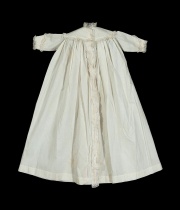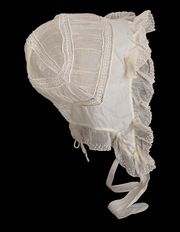Difference between revisions of "Cambric"
Jump to navigation
Jump to search
(username removed) |
|||
| (7 intermediate revisions by 4 users not shown) | |||
| Line 1: | Line 1: | ||
| − | [[File:52.411-SC36215.jpg|thumb|]] | + | [[File:52.411-SC36215.jpg|thumb|Infant nightgown<br>MFA# 52.411]] |
| + | [[File:Cambric cap MFA49951.jpg|thumb|Morning cap<br>MFA# 49.951]] | ||
== Description == | == Description == | ||
| − | A smooth, lightweight, plain weave, white fabric. Cambric originated in Cambrai, France as early as 1595 and was used for Church embroidery and table linens. The soft fabric is made from fine threads of [ | + | A smooth, lightweight, plain weave, white fabric. Cambric originated in Cambrai, France as early as 1595 and was used for Church embroidery and table linens. The soft fabric is made from fine threads of [[linen]] and occasionally [[cotton]]. It has good body and is often calendered on one side to produce a smooth surface. Cambric is used for handkerchiefs, dresses, underwear, and linings. |
== Synonyms and Related Terms == | == Synonyms and Related Terms == | ||
| Line 8: | Line 9: | ||
cambray (Esp.); batist (Ned); | cambray (Esp.); batist (Ned); | ||
| − | == | + | == Resources and Citations == |
| − | * | + | * G.S.Brady, ''Materials Handbook'', McGraw-Hill Book Co., New York, 1971 Comment: p. 248 |
| − | * | + | * Rosalie Rosso King, ''Textile Identification, Conservation, and Preservation'', Noyes Publications, Park Ridge, NJ, 1985 |
| − | * | + | * Matt Roberts, Don Etherington, ''Bookbinding and the Conservation of Books: a Dictionary of Descriptive Terminology'', U.S. Government Printing Office, Washington DC, 1982 |
| − | * | + | * Edward Reich, Carlton J. Siegler, ''Consumer Goods: How to Know and Use Them'', American Book Company, New York City, 1937 |
| − | * Wikipedia | + | * Wikipedia: http://en.wikipedia.org/wiki/Cambric (Accessed Oct. 18, 2005) |
| − | * | + | * Hermann Kuhn, ''Conservation and Restoration of Works of Art and Antiquities'', Butterworths, London, 1986 |
| − | * | + | * Random House, ''Webster's Encyclopedic Unabridged Dictionary of the English Language'', Grammercy Book, New York, 1997 |
* ''The American Heritage Dictionary'' or ''Encarta'', via Microsoft Bookshelf 98, Microsoft Corp., 1998 | * ''The American Heritage Dictionary'' or ''Encarta'', via Microsoft Bookshelf 98, Microsoft Corp., 1998 | ||
Latest revision as of 10:00, 20 October 2020
Description
A smooth, lightweight, plain weave, white fabric. Cambric originated in Cambrai, France as early as 1595 and was used for Church embroidery and table linens. The soft fabric is made from fine threads of Linen and occasionally Cotton. It has good body and is often calendered on one side to produce a smooth surface. Cambric is used for handkerchiefs, dresses, underwear, and linings.
Synonyms and Related Terms
cambray (Esp.); batist (Ned);
Resources and Citations
- G.S.Brady, Materials Handbook, McGraw-Hill Book Co., New York, 1971 Comment: p. 248
- Rosalie Rosso King, Textile Identification, Conservation, and Preservation, Noyes Publications, Park Ridge, NJ, 1985
- Matt Roberts, Don Etherington, Bookbinding and the Conservation of Books: a Dictionary of Descriptive Terminology, U.S. Government Printing Office, Washington DC, 1982
- Edward Reich, Carlton J. Siegler, Consumer Goods: How to Know and Use Them, American Book Company, New York City, 1937
- Wikipedia: http://en.wikipedia.org/wiki/Cambric (Accessed Oct. 18, 2005)
- Hermann Kuhn, Conservation and Restoration of Works of Art and Antiquities, Butterworths, London, 1986
- Random House, Webster's Encyclopedic Unabridged Dictionary of the English Language, Grammercy Book, New York, 1997
- The American Heritage Dictionary or Encarta, via Microsoft Bookshelf 98, Microsoft Corp., 1998

